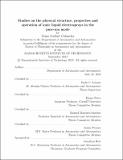| dc.description.abstract | Electrosprays operating in the pure-ion mode exhibit compelling characteristics for micropropulsion, such as the ability to achieve high specific impulses with high efficiency. Liquid metal and ionic liquid-based electrospray sources are the most well-established types that operate in this mode. Understanding the emission physics of ionic liquids has proven challenging due to their distinct differences from liquid metals, which impose limitations on the stability and current throughput of these sources. Notably, the minor role of space charge, lower surface tension coefficient, and limited conductivity of ionic liquids appear to significantly impact their operational range, restricting them to a narrow set of extracting potentials, requiring sufficient hydraulic impedance, and limiting the range of meniscus sizes to the micrometer scale. The latter constraint poses observational challenges that limit their experimental study.
Electrohydrodynamic numerical modeling has been instrumental in understanding the operational conditions of these sources, although existing models have not been able to reproduce normal experimental situations. The primary contribution of this thesis is the efficient implementation of an electrohydrodynamic model for ionic liquid electrosprays in the pure-ion mode, which can be experimentally validated, and that aims to explore electrode geometrical effects, the current and the stability of ionic liquid pure-ion electrospray menisci. The model takes into account the specific geometry of the sources and reveals emitted current ranges where the pure-ion regime can be sustained. Current bounds are wider at very small meniscus sizes (<10 𝜇m), lower critical field for emission, and higher electrical conductivity. The model unveils a potentially universal range of electric fields local to the meniscus which in the limit of high impedance, axially symmetric configuration, and negligible space charge, it can be extended to the stable cone-jet mode. This range begins at 3 the extinction voltage, where in the limit of negligible reservoir pressure, a conical geometry reminiscent of the Taylor cone is postulated and extends until the electric field near the electrode holding the meniscus reaches an electric pressure approximately twice the surface tension of a sphere with the same radius as the meniscus for the geometries tested. The specific value depends weakly on the geometrical details of the sustaining electrodes. Experimental efforts reveal that this limit likely corresponds to a bifurcation into two emitting menisci.
Further observations from the model indicate that the emitted current is likely independent of electric conductivity and the critical field for emission, similar to liquid metal ion sources. The modeling suggests that the flow rate emitted is primarily determined by upstream conditions of the flow, and in specific cases involving small meniscus sizes and low beam perveance, space charge becomes a factor. These upstream conditions encompass the local pressure, influenced solely by hydraulic impedance, surface tension coefficient, meniscus radius and reservoir pressure, as well as the local electric field near the meniscus anchoring point to the electrode, and not any coefficient with sole relevance in the emission region.
Preliminary validation efforts conducted in this thesis suggest a moving meniscus, where the radius and impedance properties of emitting pure-ion menisci may not remain constant during current-voltage excursions in porous emitters. | |
